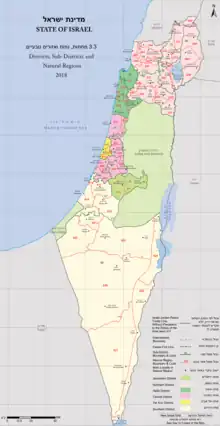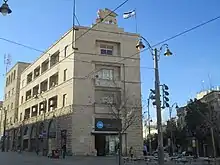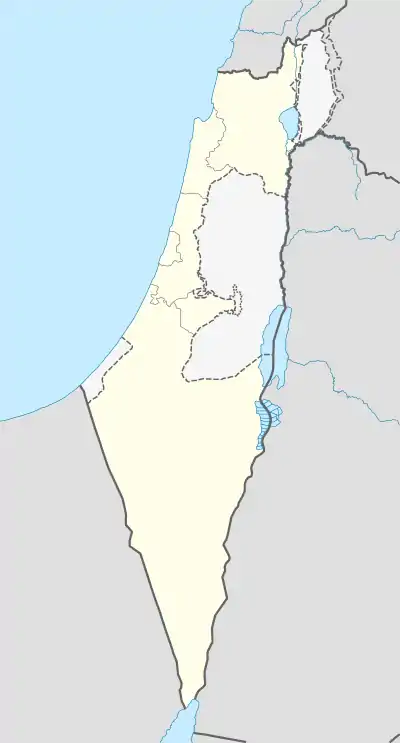| Districts of Israel מְחוֹזוֹת יִשְׂרָאֵל (Hebrew) ولايات اسرائيل (Arabic) | |
|---|---|
| Category | Unitary State |
| Location | State of Israel |
| Number | 6 Districts |
| Populations | 1,032,800 (Haifa) – 2,196,900 (Central District) |
| Areas | 190 km2 (72 sq mi) (Tel Aviv) – 14,190 km2 (5,477 sq mi) (Southern District) |
| Government |
|
| Subdivisions | |


There are six main administrative districts of Israel, known in Hebrew as mekhozot (מְחוֹזוֹת; singular: makhoz מָחוֹז) and Arabic as mintaqah and fifteen sub-districts known as nafot (נָפוֹת; singular: nafa נָפָה). Each sub-district is further divided into natural regions,[1][2] which in turn are further divided into council-level divisions: whether they might be cities, municipalities, or regional councils.
The present division into districts was established in 1953, to replace the divisions inherited from the British Mandate. It has remained substantially the same ever since; a second proclamation of District boundaries issued in 1957 – which remains in force as of 2023 – only affirmed the existing boundaries in place.
The figures in this article are based on numbers from the Israeli Central Bureau of Statistics and so include all places under Israeli civilian rule including those Israeli-occupied territories where this is the case. Therefore, the Golan sub-district and its four natural regions are included in the number of sub-districts and natural regions even though it is not recognized by the United Nations or the international community as Israeli territory. Similarly, the population figure below for the Jerusalem District was calculated including East Jerusalem whose annexation by Israel is similarly not recognized by the United Nations and the international community. The Judea and Samaria Area, however, is not included in the number of districts and sub-districts as Israel has not applied its civilian jurisdiction in that part of the West Bank.
Administration
The districts have no elected institutions of any kind, although they do possess councils composed of representatives of central government ministries and local authorities for planning and building purposes. Their administration is undertaken by a District Commissioner[3] appointed by the Minister of the Interior. Each district also has a District Court.
Since the District Commissioners are considered part of the Ministry of the Interior's bureaucracy, they can only exercise functions falling within the purview of other ministries if the appropriate Minister authorizes them.[3] This authorization is rarely granted, as other government ministries and institutions (for example, the Ministry of Health[4] and the Police[5]) establish their own divergent systems of districts.
Jerusalem District
Jerusalem District (Hebrew: מְחוֹז יְרוּשָׁלַיִם, Mehoz Yerushalayim)
District capital: Jerusalem.[a]
Natural regions:
- 111 Judean Mountains
- 112 Judean Foothills

Northern District
Northern District (Hebrew: מְחוֹז הַצָּפוּן, Mehoz HaTzafon)
District capital: Nof Hagalil
- Tzfat (sub-district) – population: 121,200
- 211 Hula Valley
- 212 Eastern Upper Galilee
- 213 Hazor Region
- 214 Central Lower Galilee
- Kinneret (sub-district) – population: 112,900
- 221 Kinerot
- 222 Eastern Lower Galilee
- Yizre'el (sub-district) – population: 520,100
- 231 Bet She’an Valley
- 232 Harod Valley
- 233 Kokhav Plateau
- 234 Yizre’el Valley
- 235 Yoqne’am Region
- 236 Menashe Plateau
- 237 Nazareth-Tir’an Mountains
- Akko (sub-district) – population: 643,300
- 241 Shefar’am Region
- 242 Karmi’el Region
- 243 Yehi’am Region
- 244 Elon Region
- 245 Nahariyya Region
- 246 Akko Region
- Golan (sub-district)[b] – population: 50,600
- 291 Hermon Region
- 292 Northern Golan
- 293 Middle Golan
- 294 Southern Golan
Haifa District
Haifa District (Hebrew: מְחוֹז חֵיפָה, Mehoz Heifa)
District capital: Haifa
- Haifa (sub-district) – population: 583,400
- 311 Haifa Region
- Hadera (sub-district) – population: 449,300
- 321 Karmel Coast
- 322 Zikhron Ya’aqov Region
- 323 Alexander Mountain
- 324 Hadera Region
Central District
Central District (מְחוֹז הַמֶּרְכָּז, Mehoz HaMerkaz)
District capital: Ramla
- Sharon (sub-district) – population: 477,400
- 411 Western Sharon
- 412 Eastern Sharon
- Petah Tikva (sub-district) – population: 754,300
- 421 Southern Sharon
- 422 Petah Tiqwa Region
- Ramla (sub-district) – population: 351,700
- 431 Modi’in Region
- 432 Ramla Region
- Rehovot (sub-district) – population: 612,600
- 441 Rehovot Region
- 442 Rishon LeZiyyon Region
Tel Aviv District
Tel Aviv District (Hebrew: מְחוֹז תֵּל־אָבִיב, Mehoz Tel Aviv)
District capital: Tel Aviv
- 511 Tel Aviv Region
- 512 Ramat Gan Region
- 513 Holon Region
Southern District
Southern District (Hebrew: מְחוֹז הַדָּרוֹם, Mehoz HaDarom)
District Capital: Beersheba
- Ashkelon (sub district) – population: 551,200
- 611 Mal’akhi Region
- 612 Lakhish Region
- 613 Ashdod Region
- 614 Ashqelon Region
- Be'er Sheva (sub-district) – population: 750,700
- 621 Gerar Region
- 622 Besor Region
- 623 Be’er Sheva Region
- 624 Dead Sea Region
- 625 Arava Region
- 626 Northern Negev Mountain
- 627 Southern Negev Mountain
Formerly the Hof Aza Regional Council with a population of around 10,000 Israelis was part of this district, but the Israeli communities that constituted it were evacuated when the disengagement plan was implemented in the Gaza Strip. Since the withdrawal, the Coordination and Liaison Administration operates there.
Judea and Samaria Area
Judea and Samaria Area (Hebrew: אֵזוֹר יְהוּדָה וְשׁוֹמְרוֹן, Ezor Yehuda VeShomron)
Largest city: Modi'in Illit
The name Judea and Samaria for this geographical area is based on terminology from the Hebrew and other sources relating to ancient Israel and Judah/Judea. The territory has been under Israeli control since the 1967 Six-Day War but not annexed by Israel, pending negotiations regarding its status. It is part of historic Israel, which leads to politically contentious issues. However, it is not recognized as part of the State of Israel by the United Nations and most nations.
There are no sub-districts and no natural regions in the Judea and Samaria Area.[1]
See also
Notes
- ^ a: This district includes areas captured in the 1967 Six-Day War and annexed to Israel in the Jerusalem Law.
- ^ b: Occupied in the 1967 Six-Day War and internationally unrecognized annexed by Israel's Golan Heights Law.
References
- 1 2 Key to the Codes in the Maps - Districts, Sub-Districts and Natural Regions 2018, Israel Central Bureau of Statistics, 2021
- ↑ Districts, Sub-Districts and Natural Regions 2018, Israel Central Bureau of Statistics, 2021
- 1 2 "Transfer of Power (District Commissioners and District Officers) Law, 5724-1964, Laws of the State of Israel vol. 18 no 38. (pp. 70-71)" (PDF).
- ↑ "Polio Vaccination Centers across Israel". Ministry of Health Israel. Retrieved 2022-04-27.
- ↑ "Maps". www.police.gov.il (in Hebrew). Retrieved 2022-04-27.
- 1 2 3 4 5 6 7 "Localities and Population, by District, Sub-District, Religion and Population Group" (PDF). Israel Central Bureau of Statistics. 2019. p. 1. Retrieved July 24, 2020.
- 1 2 3 4 5 6 Statistical Abstract – Geography (PDF) (Report) (in Hebrew). Israel Central Bureau of Statistics. 2016. p. 15 (PDF p. 9). Retrieved December 24, 2017.
External links
- Central Bureau of Statistics Archived 2020-08-06 at the Wayback Machine – detailed breakdown of each district, sub-district, and natural region.
